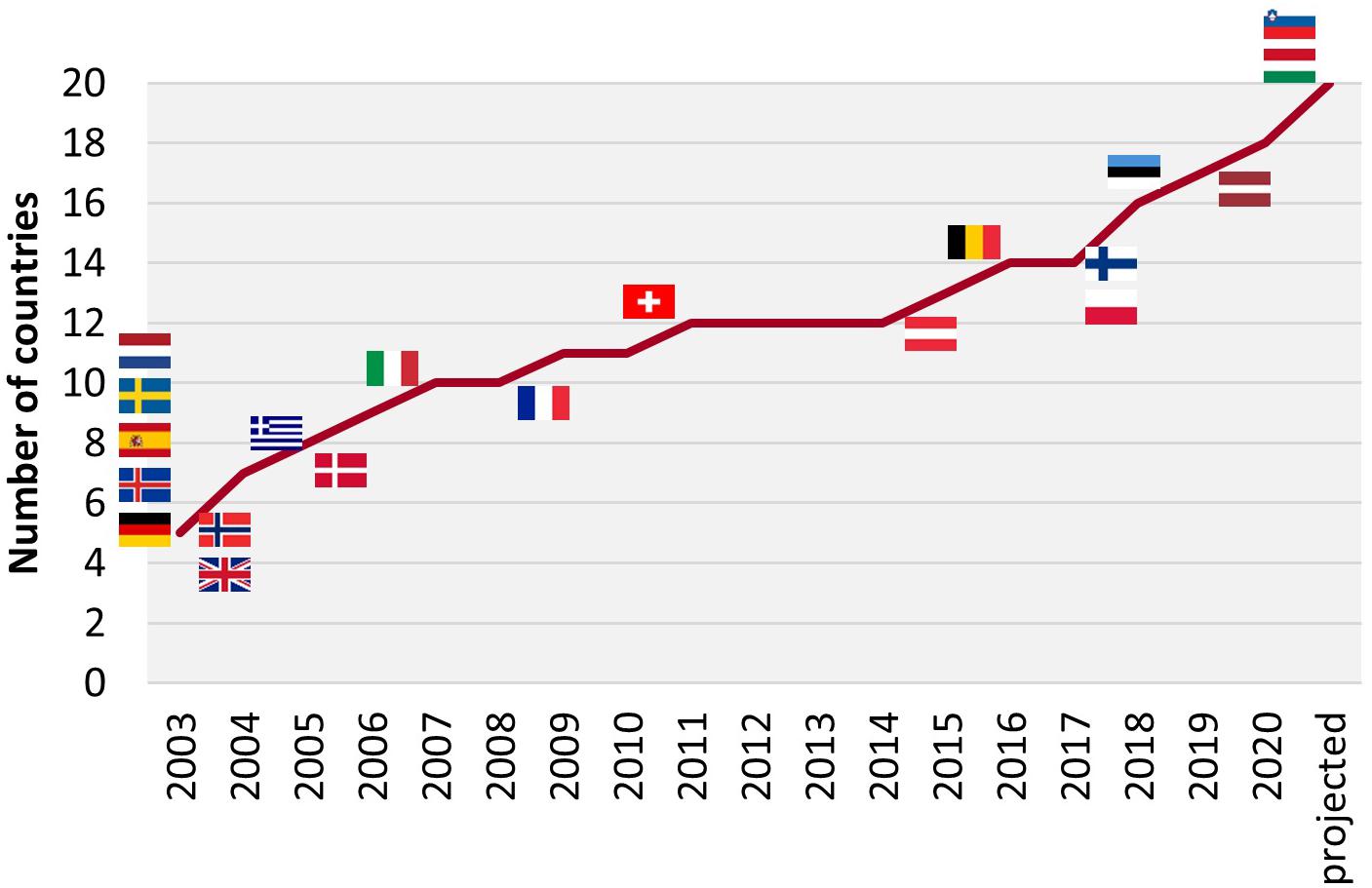Review of Power-to-X Demonstration Projects in Europe
- Institute of Energy and Climate Research – Systems Analysis and Technology Evaluation, Forschungszentrum Jülich, Jülich, Germany
At the heart of most Power-to-X (PtX) concepts is the utilization of renewable electricity to produce hydrogen through the electrolysis of water. This hydrogen can be used directly as a final energy carrier or it can be converted into, for example, methane, synthesis gas, liquid fuels, electricity, or chemicals. Technical demonstration and systems integration are of major importance for integrating PtX into energy systems. As of June 2020, a total of 220 PtX research and demonstration projects in Europe have either been realized, completed, or are currently being planned. The central aim of this review is to identify and assess relevant projects in terms of their year of commissioning, location, electricity and carbon dioxide sources, applied technologies for electrolysis, capacity, type of hydrogen post-processing, and the targeted field of application. The latter aspect has changed over the years. At first, the targeted field of application was fuel production, for example for hydrogen buses, combined heat and power generation, and subsequent injection into the natural gas grid. Today, alongside fuel production, industrial applications are also important. Synthetic gaseous fuels are the focus of fuel production, while liquid fuel production is severely under-represented. Solid oxide electrolyzer cells (SOECs) represent a very small proportion of projects compared to polymer electrolyte membranes (PEMs) and alkaline electrolyzers. This is also reflected by the difference in installed capacities. While alkaline electrolyzers are installed with capacities between 50 and 5000 kW (2019/20) and PEM electrolyzers between 100 and 6000 kW, SOECs have a capacity of 150 kW. France and Germany are undertaking the biggest efforts to develop PtX technologies compared to other European countries. On the whole, however, activities have progressed at a considerably faster rate than had been predicted just a couple of years ago.
Introduction
Future energy systems with high shares of renewable energies and aims to achieve the goals set out in the Paris Agreement will place a high demand on energy storage systems. Furthermore, electricity will be increasingly used in the heat, transport, and industry sectors, i.e., sector coupling (e.g., Ram et al., 2019), which will – to some extent – require transformation into other energy forms.
Electricity can be used directly in other sectors, for example with battery electric vehicles, or it can be processed into other energy carriers that are more versatile in their use and can be better stored. Such concepts are known as Power-to-X (PtX), since electrical energy is transformed into different products. A key stage of this concept is the production of hydrogen by water splitting in an electrolyzer. Often, hydrogen or further processed methane are the final products. These concepts are referred to as Power-to-Gas (PtG), a name often used synonymously with all PtX applications.
In Figure 1, an overview of basic PtX process chains is given. The focal point of most pathways is the electrolysis process to produce hydrogen. The required electricity often comes from variable renewable energy (VRE) generation, for example wind or photovoltaics, either directly or in the form of certificates (e.g., Pearce, 2015; Bauer, 2016; BIGH2IT, 2017; Büssers, 2019), and less frequently from the grid. The use of grid electricity, however, often contradicts the original idea behind PtX – to use and store renewable energy (RE) – as electricity produced from fossil fuels still makes up a considerable share of most national grids. Projects using grid electricity either focus on hydrogen production or processing (Moser et al., 2018), or they aim to provide peak shaving electricity to the grid (Hänel et al., 2019).
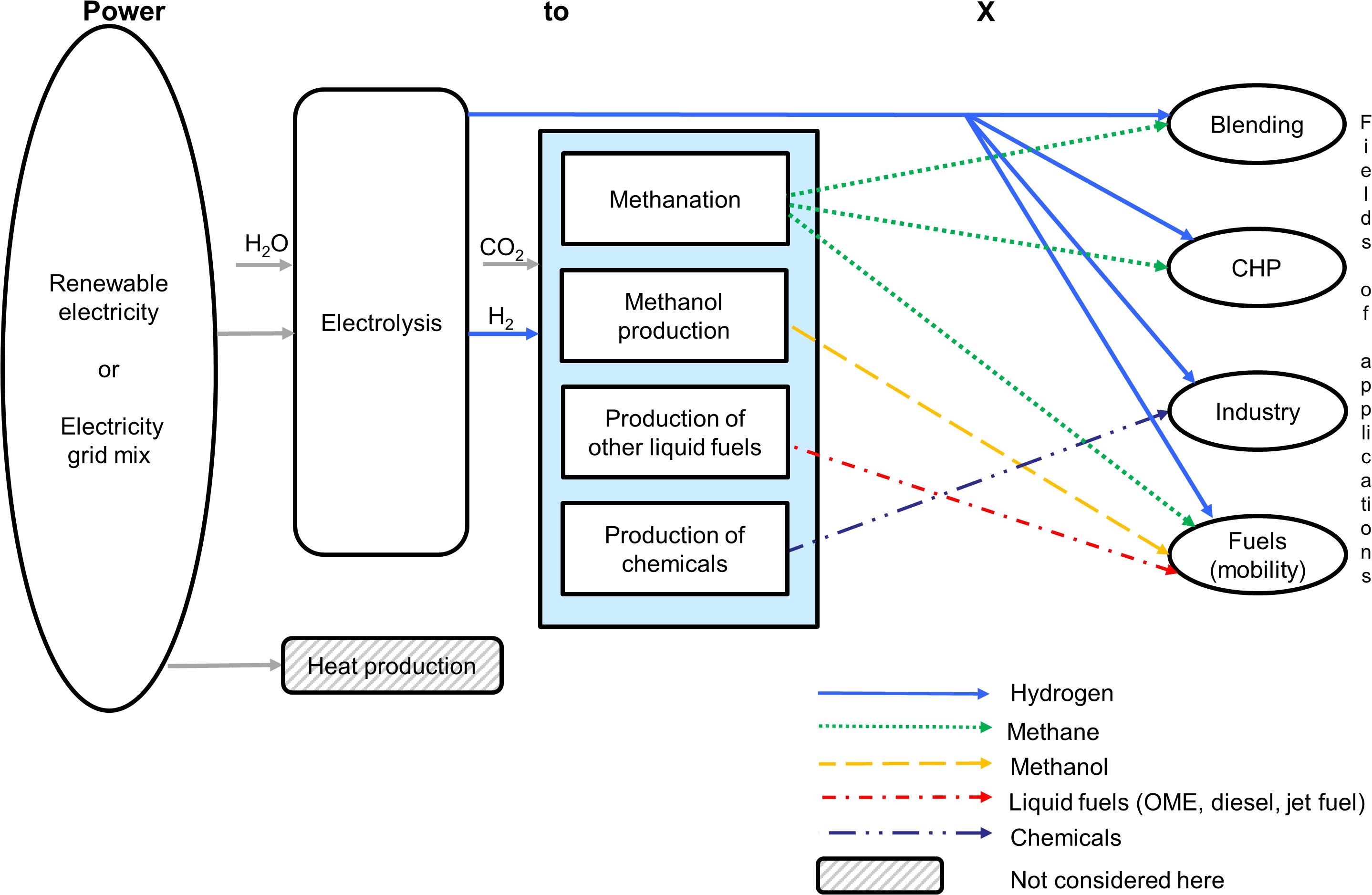
Figure 1. Overview of Power-to-X process chains based on hydrogen. CO2, carbon dioxide; H2, hydrogen; H2O, water; CHP, combined heat and power; OME, polyoxymethylene dimethyl ether.
If further processing is emphasized, carbon dioxide is a necessary feedstock to process hydrogen into other energy carriers or industrial products such as methane or chemicals (Hendriksen, 2015; MefCO2, 2019). To foster a climate-friendly energy system, non-fossil fuel carbon dioxide sources should, of course, be favored. However, in some research projects, fossil carbon is used due to it being easily accessible from existing test facilities for carbon capture and use (CCU; Moser et al., 2018). In future, fossil fuel-based power plants will be less, or not at all, available. The knowledge gained from such projects, however, can be used for other power plants, such as municipal waste treatment (MWT). Other carbon dioxide sources include industrial processes [(CCU P2C Salzbergen) BMWi, 2019], the anaerobic digestion of biomass (e.g., Rubio et al., 2016; Sveinbjörnsson and Münster, 2017), direct air capture (DAC; BMBF, 2018), and other biogenic sources.
Alongside methanation, other options for hydrogen-based fuels are methanol, Fischer–Tropsch diesel (BMBF, 2018), or dimethyl ether (DME; Moser et al., 2018). Another possibility is the production of synthesis gas, a mixture of hydrogen and carbon monoxide, in a reversed water–gas shift reaction or co-electrolysis (Andika et al., 2018; Wang et al., 2019). This technology splits water electrochemically and simultaneously produces synthesis gas from the hydrogen and the added carbon dioxide in a single process.
There is a diverse range of applications for hydrogen or hydrogen-based products. Hydrogen and fuels can be used in mobility applications (HyFLEET:Cute, 2009), for re-electrification in combined heat and power (CHP) plants (Exytron, 2019), or in industrial applications, for example refineries (H&R, 2017) or steel production [H2Stahl (BMWi, 2019)]. Furthermore, hydrogen can substitute fossil fuel-based feedstocks in the chemical industry [(CCU P2C Salzbergen) BMWi, 2019].
Another way to use electricity across multiple sectors is through direct conversion into heat, which is a standard application in many cases, for example heat pumps. In industrial applications, an increasing number of electrode boilers have been installed over the last few years. However, an analysis of this kind of technology is beyond the scope of this article.
As the number of PtX projects has increased, so too has the number of reviews. A first overview of PtX projects was published by Gahleitner (2013). It focused on global projects from laboratory scale to demonstration plants. Gahleitner identified 64 projects, 48 of which included a detailed assessment. Bailera et al. (2017) analyzed lab, pilot, and demonstration projects on a global scale. They identified 66 projects, highlighting 23 of them and focusing on catalytic methanation. A first overview focusing on Europe was given in an earlier publication by Wulf et al. (2018). We explicitly excluded lab projects, and still found 128 projects in 16 countries. One year later, Thema et al. (2019) published a review with 153 projects from 22 different countries on a global scale, also including lab projects and older projects dating back to 1988. They also included a cost and capacity projection for installed electrolyzers until 2050 as well as geospatial data. Although the authors included an analysis of the countries involved, there was no detailed discussion on this subject. Based on Task 38 of the International Energy Agency’s (IEA) Hydrogen Technology Collaboration Programme, Chehade et al. (2019) performed a similar analysis and identified 192 PtX demonstration projects in 32 countries. The authors focused on the different fields of applications and objectives (economic or non-economic) and various hydrogen storage technologies, and also assessed the efficiency of the electrolyzers. They did not include projects that have only been projected or announced. This confirms the conditions for previous years, but does not reflect current or even future perspectives.
Although these articles offer a good overview of the development of PtX technologies, they stopped collecting data in early 2018 (Chehade et al., 2019) and late 2018 (Thema et al., 2019), respectively. However, in 2019 and at the beginning of 2020, several multi-MW projects were announced, which offer a perspective for the future. Lab-scale projects as well as projects initiated before 2000 have been excluded from this article to focus on recent developments. Furthermore, all previous reviews show that Europe has been the leading region for these technology concepts for several years now. Therefore, only European projects are considered here. We also discuss qualitative trends in terms of certain countries or technological features using examples of different projects. This overview clearly shows how the scope of a review can influence the results. Chehade et al. (2019) provided a review on a global scale, which also included lab-scale projects. For the years 2010–2014, they identified 78 eligible projects, while only 37 are taken into account here. As 80% of the projects they identified are European, the consideration of lab-scale projects can be seen as the major difference.
Methodology
Power-to-X projects were identified through extensive internet research. Many sources took the form of press releases from companies announcing a new project. Frequently used publications included BWK Das Energie-Fachmagazin, the German Hydrogen and Fuel-Cell Association (DWV) Mitteilungen (membership magazine), the project database of the German Energy Agency (dena, 2020), and the German Technical and Scientific Association for Gas and Water (DVGW, 2019). Non-German literature reporting frequently about new PtX projects is – to the best of our knowledge – not available. While these sources provided an initial indication of a new project, we also sought out announcements of each project in English. The same applies for publications in French, Danish, and other European languages, although this was not always available.
To qualify as a project for this publication, the project must be located in Europe, have been initiated after the year 2000, and have a technology readiness level of five or higher (EU, 2014). The other review articles mentioned in the introduction were used to validate the data before 2018.
The analyzed topics can be arranged into three categories:
• General information: location (country base), year of commissioning (electrolyzer), out of operation (yes/no).
• Technical specifications: power and carbon dioxide supply, type of electrolyzer, capacity of electrolyzer, type of hydrogen processing (e.g., catalytic methanation).
• Field of application: gaseous or liquid fuels, industrial application, heat and power generation, blending into the natural gas grid.
Results and Discussion
For the analysis, 220 projects that meet the set criteria were identified by June 2020. Twenty different countries are currently undertaking PtX projects, with an increasing number becoming interested in these technological concepts. A complete list of these projects can be found in the Supplementary Material. This section is structured into three sections according to the categories mentioned above. The first section provides an overview of the historical development of PtX in the different countries and discusses how they use different strategies. The second section features a discussion of current and planned installed electrolyzer technologies as well as their capacities. The third and final section takes a look at the design of the X phase and which electrolyzer technology is used for what purpose.
General Information
From Figure 2, it can be seen that 2018 was the year with the most commissioned projects so far in Europe. In the years to come, fewer projects will be initiated, but the data also shows that installed capacity is still growing rapidly. It also seems that PtX development is following a wave-like pattern with peaks in 2015, 2018, and 2020. Experience has shown, however, that some of the projects scheduled for 2020 will be delayed to 2021 due to technical difficulties and delayed approvals as well as the special circumstances surrounding the global COVID-19 crisis. The year 2024 is also expected to stand out, due to a situation specific to Germany. It had been assumed that the regulatory sandboxes (Reallabore) funded by the German Federal Ministry for Economic Affairs and Energy1 that can be classified as PtX projects (ten out of 20) would be commissioned in 2024, if they were yet to have published a commissioning year. Furthermore, the three HyPerformer projects (NOW, 2019) are expected to begin in 2025, which is also a conservative estimation since these projects received their notification of funding in December 2019. It has been generally assumed that commissioning takes place in the penultimate year of the project, based on the experience of earlier projects.
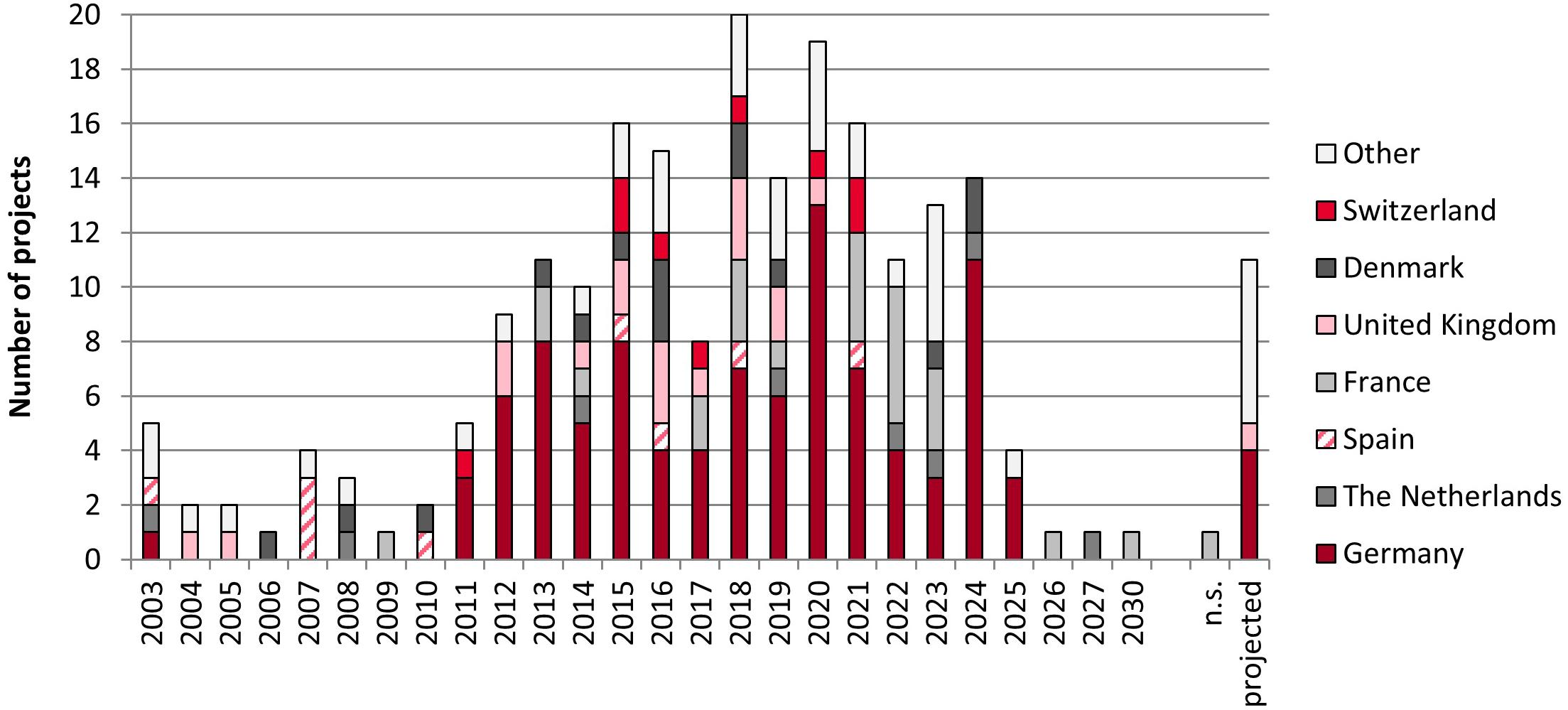
Figure 2. Historical development of Power-to-X projects commissioned in Europe with regard to the countries involved; year for commissioning not specified (n.s.).
Twenty European countries are engaged in PtX projects. Furthermore, one pan-European project including the Netherlands, Denmark, and Germany is currently being planned, in which hydrogen is to be produced offshore in the North Sea right next to wind parks with connections to bordering countries (NSWPH, 2019). The country with the most PtX projects is Germany, representing 44% of all identified projects. In the first few years, PtX projects were developed in several different countries. Since 2011, however, Germany has started to increase its interest in this technology, with at least four new projects per year and 13 new projects in 2020.
The interest of different countries in PtX projects has been growing constantly over the last few years (see Figure 3). However, in the years to come, the only new countries to launch PtX projects will be Hungary and Slovenia.
Figure 4 shows the installed capacities of European countries in the last five years and the next five years. As expected, due to its large number of projects (Figure 2), Germany has had the largest installed capacity over the last five years and this is set to increase significantly in the next five years. Demonstration projects have also been realized in several other countries. However, it appears that in the future, these technologies will be implemented by fewer countries but with a higher intensity. Germany, France, the Netherlands, Belgium, and Denmark stand out in particular. Over the next five years, 494 MW of installed electrolyzer capacity is scheduled in Germany. In addition, there are plans for seven more projects, which have not yet specified their electrolyzer capacity, but which will likely also be on the multi-MW scale. In France, 514 MW are projected to be installed in this time period. It is also worth mentioning that in France, this capacity will largely be achieved by two projects alone. The developer H2V PRODUCT (Meillaud, 2019; H2V, 2020) is set to install 500 MW of capacity. In contrast, seven hydrogen projects for fuel provision (hydrogen refueling stations) funded by ADEME (Agence de l’environnement et de la maîtrise de l’énergie) are rather minor (around 1 MW) (FuelCellsWorks, 2020a). In Germany, 28 projects are scheduled for this period. Here, the main drivers of installed capacity are the aforementioned regulatory sandboxes [6 of the 10 projects will have a capacity of 220 MW (BMWi, 2019]). Surprisingly, the United Kingdom has only announced one new PtX project (ITM, 2020a), despite having been relatively active in the past. Furthermore, the United Kingdom’s Committee on Climate Change has called for an increased national effort when it comes to using hydrogen in industry and other sectors (Stark et al., 2019). One reason for this might be that in the United Kingdom, hydrogen production from steam methane reforming, which is connected to carbon capture and storage/use in the long term, is being discussed (Bottrell Hayward, 2020). Belgium is an example of a country that has shown little interest in this kind of technology (one project with only 130 kW installed capacity), but is now announcing relatively major projects (one with a capacity of 25 MW and another with a capacity of 50 MW). In Spain, a similar development can be observed. In the 2000s, small projects were developed, whereas the target is now for capacities on the multi-MW scale. Eastern European countries rarely invest in PtX projects. Only Poland, Estonia, and Latvia currently have active projects. Latvia and Estonia are following the same pathway as the countries involved in the Clean Urban Transport for Europe (CUTE) project (Binder et al., 2006) in 2003, initiating their hydrogen activities with an EU project [H2Nodes (FuelCellsWorks, 2020b)] for fuel cell buses. However, the EU has established a new funding scheme – Important Project of Common European Interest (IPCEI) – that aims to support countries that are not yet active in PtX development. Furthermore, an IPCEI on hydrogen is currently under development and aims to close the gap between research and development projects and commercialization (Hydrogen for Climate Action, 2020). The first projects should be approved by the end of 2020. The central idea behind many of these projects is to produce hydrogen (further processing is not yet planned) in sunny and windy regions, to use some of the hydrogen for local mobility applications, and to export the rest of the hydrogen to other countries.
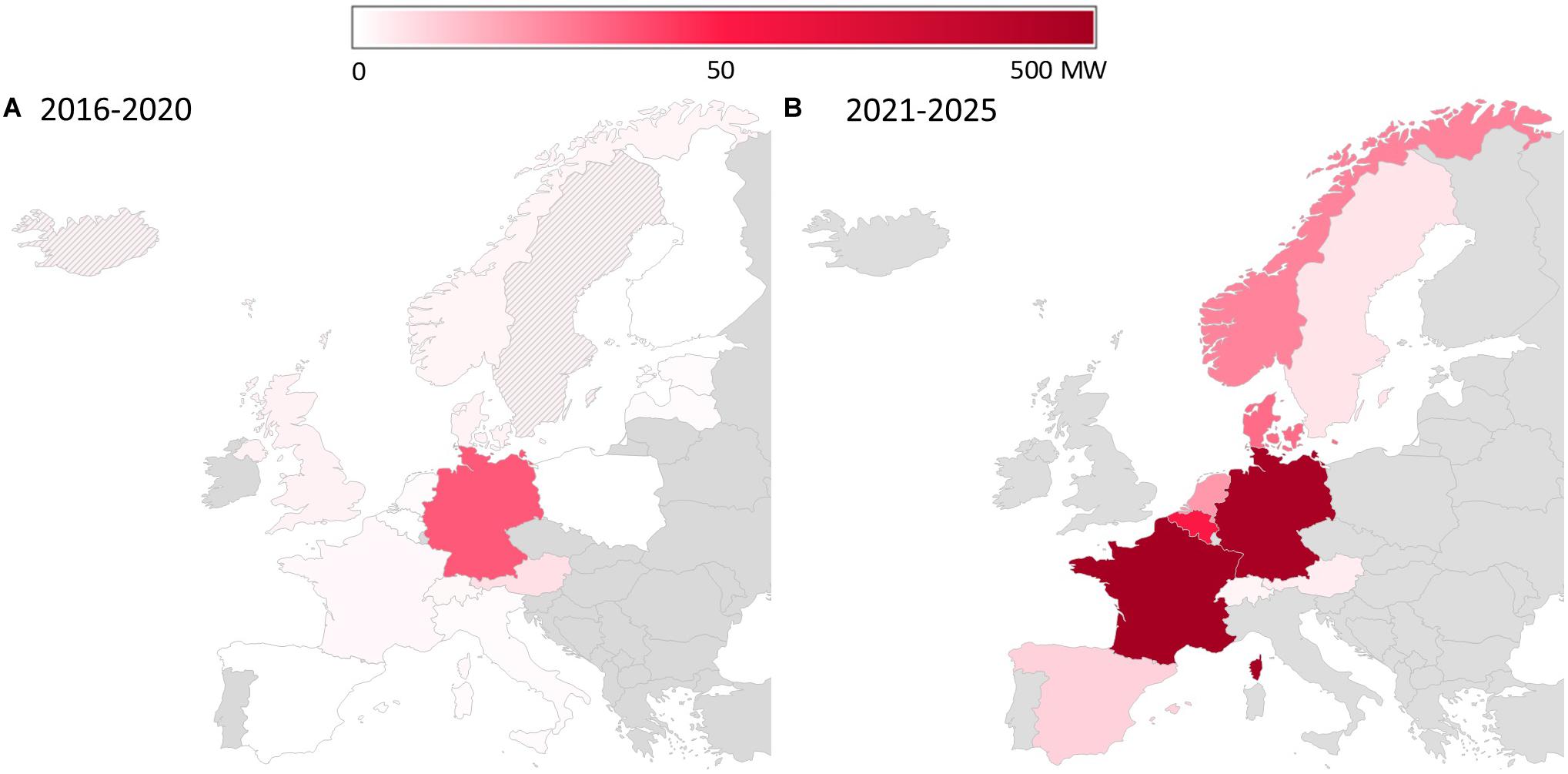
Figure 4. Newly installed capacities of Power-to-X projects in Europe, (A) commissioned between 2016 and 2020, (B) planned for 2021–2025. Shaded countries: installed capacity not specified, gray countries: no Power-to-X projects.
If available, data about the decommissioning of the projects were also gathered (see Supplementary Material). However, such data are hard to come by and too incomplete to allow for a meaningful analysis. In some R&D projects, even the installed technologies are passed on to a follow-up project, for example MefCO2 and FReSMe (2017).
Technical Specifications
The analyzed technical specifications include a power and carbon dioxide supply, electrolyzer types, and capacities, as well as technologies for hydrogen processing.
Energy Sources
Energy sources have a major impact on PtX. One argument for PtX is the storage of intermittent energy sources of VRE. Almost half (105) of the projects consider a supply by direct RE technologies, such as wind, photovoltaics, geothermal, or hydropower plants. There is no clear trend as to which renewable technology is preferred, neither in connection to specific electrolyzer types, nor to capacity sizes, nor to countries. Twelve projects describe their PtX benefit as being able to store surplus energy from renewables, which would be retailed otherwise. This line of argumentation can be mainly seen with German projects. It remains uncertain what the real amount of surplus energy is and what its availability will look like in the future, but the key message is to use RE sources. This is especially true for projects in countries with a high share of electricity produced from fossil fuels as well as all planned projects that rely on certificates (Hulshof et al., 2019). However, almost 13% (28) of the projects do not include an energy source. They either use electricity from the national grid (whose share of renewables might be quite low) or do not specify the energy source. In particular, during the last decade, Germany, Denmark, and the United Kingdom have had several projects, in which the demonstrator was connected to the grid. One project explicitly focuses on the peak shaving of the national grid (Hänel et al., 2019). Most other projects focus on the feasibility of hydrogen production or processing for different applications, rather than demand side management or the demonstration of VRE electricity storage potential. Figure 5 shows the development of different energy source options, making a distinction between direct RE technologies, certificates for RE electricity, surplus RE electricity, and the national grid (not specified sources are included here for simplification).
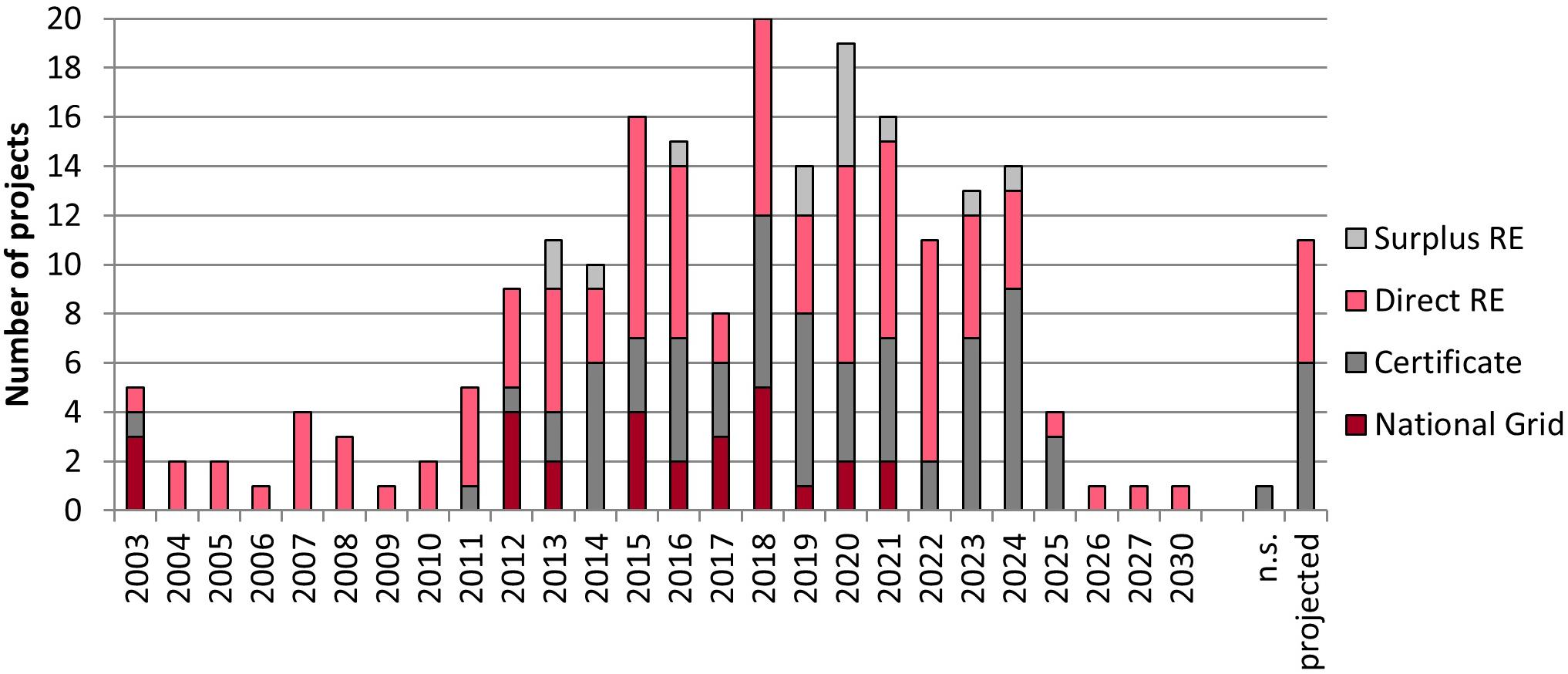
Figure 5. Historical development of Power-to-X projects with regard to electricity supply. RE, renewable energy.
Considering the countries with the highest number of projects (Germany, France, Denmark, and United Kingdom), no preference for a specific type of electricity supply can be identified. However, there is a clear trend toward including RE sources in projects.
Carbon Dioxide Source
About one third of the projects (70) process hydrogen into other gases, liquid fuels, or chemicals (see section “Hydrogen processing”), predominantly in Germany (38). The capture of the required carbon dioxide is also included in the PtX project in the majority of cases (60). The sources of the carbon dioxide, however, vary from project to project. To underline the notion of non-fossil carbon sources, the majority (27) of projects obtain carbon dioxide from biogas or biomass plants. In Iceland, the country-specific option of geothermal carbon dioxide is used. A small number of projects (seven) obtain carbon dioxide from nearby industry sites or even lignite power plants. These large point sources already have capture technologies installed and are seeking utilization options (CCU), since storage options (CCS) are not currently available for these sources. This might be a temporary solution, as large industrial carbon dioxide emitters, such as the steel industry in the case of Sweden, and especially the electricity generation industry will have to change to a low carbon future. However, right now, they can provide carbon dioxide in considerable amounts [e.g., 7.2 t CO2/day (Moser et al., 2018)]. These projects provide an insight into the handling and purification requirements of future industrial carbon dioxide sources, which will still exist due to process-related reactions, such as for the cement industry. Projects from the Exytron Group (Schirmer, 2020) require one filling of carbon dioxide from an external source, with carbon dioxide then being captured and recycled from CHP plants using synthetic methane produced through PtX. In addition, carbon dioxide emissions will be emitted in the future during wastewater treatment and waste incineration. Therefore, nine projects include such facilities as a carbon dioxide source. An industry-independent source is provided by DAC. Ambient air generally flows through a filter where either adsorption, absorption, or mineralization removes carbon dioxide from air. Due to the very low carbon dioxide content of air and its resulting high energy demand (heat and electricity), this concept has proven controversial (Fasihi et al., 2019). Nevertheless, this Climeworks AG technology is included in seven out of eight projects, often in combination with solid oxide electrolyzer cell (SOEC) electrolyzers using the synergy of thermal integration in the concept.
Electrolyzer Type and Capacity
Alkaline electrolyzers have been used in previous projects and will continue to be used in future projects, thus indicating the constant development of this technology. Since 2015, polymer electrolyte membrane (PEM) electrolyzers have gained high shares of the market due to their good partial load range and dynamic behavior. Four projects aim to compare these two technologies and integrate both into their system design. Several attempts have been made to use SOECs in PtX projects, but this technology remains at a much lower technology readiness level. A more uncommon technology is the alkaline solid polymer electrolyte electrolyzer, which is a hybrid between a PEM and an alkaline electrolyzer. This technology was used in three projects. However, the installed capacities are rather small and future demonstration projects using this technology have yet to be announced. From 2022 onward, the share of projects with no dedicated electrolyzer technology is set to increase, which is understandable, since it has not yet been decided which technology is used. Unfortunately, over the past few years, the electrolyzer technology used has not been specified, which results in a total of 24% of the projects with no information about the technology.
The cumulative installed capacity (see Figure 62) shows a constant increase with a noticeably higher rise from 2021 onward. Until the end of 2020, 93 MW of electrolyzer capacity is planned to be installed. The biggest projects (all with 6 MW of capacity) are the Audi e-gas project (commissioned 2013, alkaline electrolyzer) (Köbler, 2013), the Energiepark Mainz (commissioned 2015, PEM electrolyzer) (Energiepark Mainz, 2016) both in Germany, and the new H2Future project (commissioned 2019, PEM electrolyzer) in Austria (voestalpine, 2019). The expected capacities for the upcoming years are presented. They are all based on project announcements, many of which have secured funding. Until 2025, the biggest projects will have a capacity of 100 MW. Four projects fall under this category: Element Eins (scheduled for 2022) (E1, 2019) and hybridge (2019) (scheduled for 2023) – both in Germany – as well as H2V59 (also scheduled for 2022) (H2V, 2020), and the second H2V PRODUCT project – both in France – with 400 MW of capacity (planned for 2022/23) (Meillaud, 2019). From 2026 onward, even bigger projects have been announced, increasing the total installed capacity for electrolyzers to 1.8 GW. The largest single project is HyGreen Provence 2 with 435 MW of installed capacity planned in the final stage by 2030 in France (Le Hen, 2019; Saveuse, 2020). Thema et al. (2019) predicted exponential growth of cumulative installed capacity. Based on the published project data, this appears to be a considerable underestimation, even for the near future. For 2026, they predicted roughly 300 MW of installed capacity worldwide. The research presented here, however, shows that in Europe alone, 1410 MW is expected to be installed by 2026. The main drivers behind this acceleration of growth are the publicly funded projects in many sectors in Germany and several high-investment industry projects in France, for example H2V PRODUCT (Le Hen, 2019).
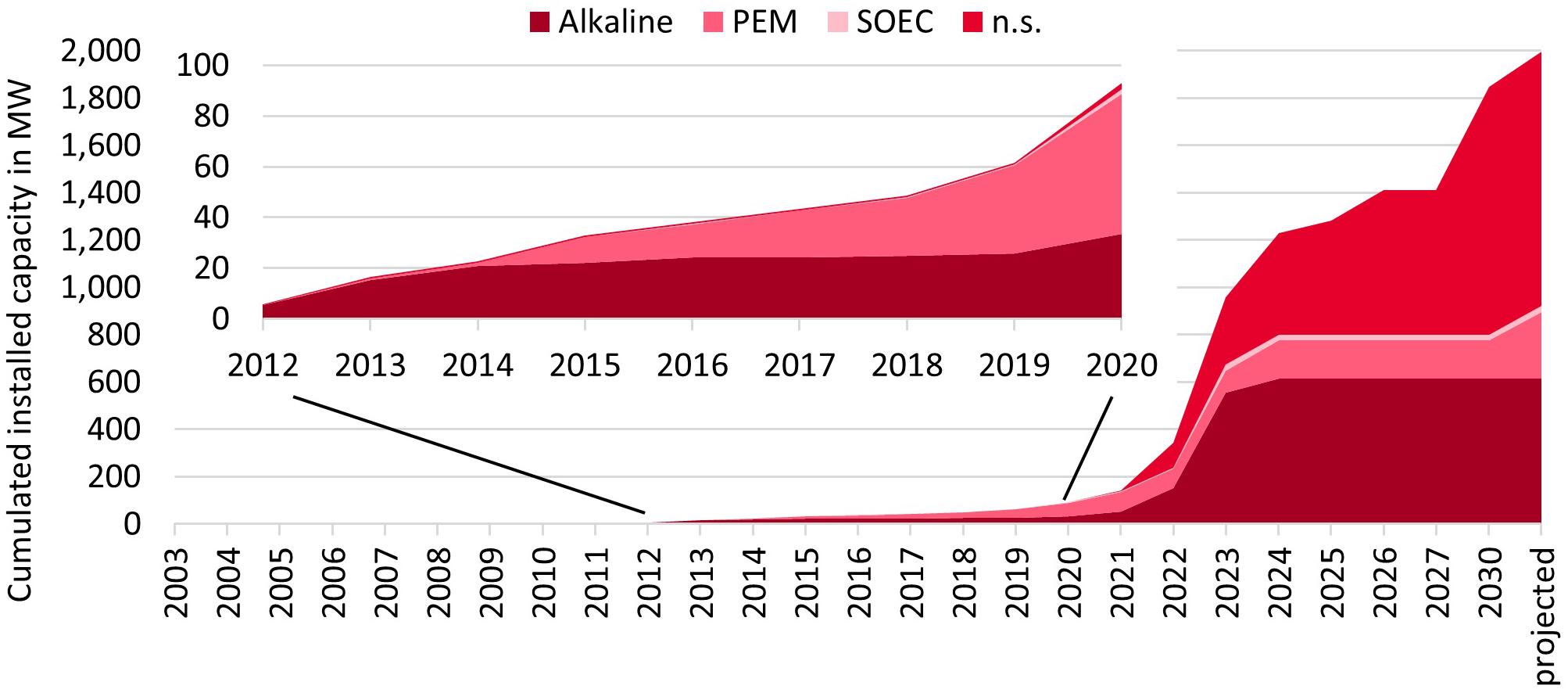
Figure 6. Cumulative installed capacity according to electrolyzer type. n.s., not specified; PEM, polymer electrolyte membrane; SOEC, solid oxide electrolyzer cell.
A closer look at the years between 2012 and 2020 with regard to installed capacity and the electrolyzer technology used is also shown in Figure 6. It demonstrates the growing importance of PEM technology for hydrogen production. Not only is the number of projects utilizing PEM electrolyzers constantly growing (Figure 7) but so too the installed capacities. 2019 was the first year in which more PEM electrolyzer capacity was installed than alkaline electrolyzer capacity (cumulatively). However, alkaline electrolyzers will play an important role again. For example, the 100 and 400 MW PtX projects in France, which are part of the H2V PRODUCT project, will be equipped with alkaline electrolyzers (HydrogenPro, 2019). Due to the level of technological development, only a low level of capacity has been installed for SOECs over the last few years. This technology still needs to demonstrate its usability beyond niche applications. The MultiPLHY project aims to install a 2.6 MW SOEC electrolyzer in a biorefinery (European Commission, 2020). In the same year (2023), an industrial project with a 20 MW electrolyzer capacity is set to be installed in Herøya, Norway to produce jet fuel using the Fischer–Tropsch process (Norsk e-Fuel, 2020). This would be a much faster technological development from a multi-MW scale to greater than 10 MW than was the case for PEM or alkaline electrolyzers. For alkaline electrolyzers, it took ten years from the first demonstration projects to achieve a multi-MW scale and another eight years to reach 10 MW. For PEM, it took seven years to achieve the first multi-MW scale and another five years to reach 10 MW. For SOECs, the first step of technological development took nine years – in contrast to PEM and alkaline electrolyzers – the second step, however, is expected to follow instantly.
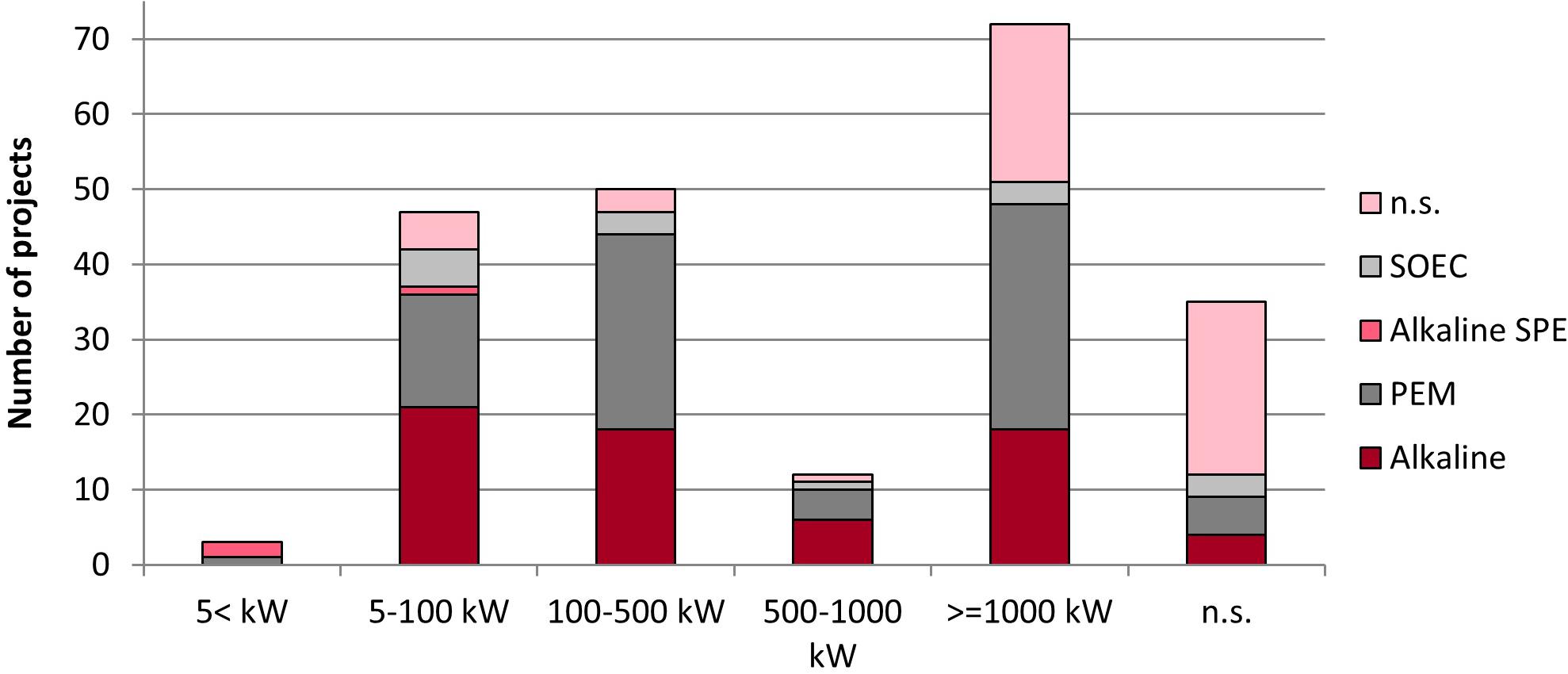
Figure 7. Electrolyzer types according to capacity. PEM, Polymer electrolyte membrane; SOEC, solid oxide electrolyzer cell; SPE, solid polymeric electrolyte.
In Figure 7, the distribution of electrolyzer capacities is depicted. The smallest class of electrolyzers (below 5 kW) is used extremely rarely, because they are too small for demonstration projects and are only considered for laboratory use. For electrolyzers below 100 kW, alkaline electrolyzers tend to be used. This is because of earlier projects, during which small capacities were installed and the preferred technology was alkaline electrolysis due to its higher maturity back then. On the other hand, the Exytron projects (Schirmer, 2020) – most of which have a capacity of 100 kW or below – will all use alkaline electrolyzers, stating the cost advantages of this technology due to its higher maturity. At present, SOECs are predominantly installed at a capacity between 100 and 500 kW, although they are less developed than PEM and alkaline electrolyzers. A trend toward smaller capacities might have been expected due to the lower level of technological development. Electrolyzers with a capacity between 0.5 and 1.0 MW are rarely used. Electrolyzer developers decided to opt directly for a size bigger than 1 MW. For sizes above 1 MW, more PEM electrolyzers are installed than alkaline electrolyzers. A relatively high share of projects, which have not yet defined their electrolyzer technology, are set to install multi-MW electrolyzers. Furthermore, a significant number of projects have not yet made a decision on electrolyzer type or capacity.
Hydrogen Processing
At present, only around one third of the projects are processing hydrogen into other fuels and products (see Figure 8). If hydrogen is treated further, mainly methane is produced that can be easily injected into the natural gas grid. Methanation can be realized in a catalytic and biological way. Biological methanation, for example, can be used if biogas or sewage gas needs to be upgraded to biomethane by injecting hydrogen into the biogas. A good example of the holistic use of PtX is its application in wastewater treatment plants. In the Swisspower Hybridkraftwerk project (Viessmann, 2019), hydrogen is used to enhance the methane content in the sewage gas. In another PtX project – LocalHy in Germany – the additional oxygen produced is used directly for wastewater treatment (localhy, 2019). Denmark is another country with several biological methanation projects. Catalytic methanation shows higher efficiencies, but it is also more complex from a technical perspective. However, the Exytron projects – seven projects with CHP production in residential buildings – show that catalytic methanation is on its way toward commercialization (Schirmer, 2020). Although the number of projects suggest a balance between catalytic and biological methanation, catalytic methanation is more commonly used in bigger projects, as Thema et al. (2019) have also stated (twice as much capacity for catalytic methanation). The trend becomes even more apparent when considering very recent projects. In the foreseeable future, 19 MW of installed electrolyzer capacity will be connected to biological methanation, and 122 MW to catalytic methanation. Furthermore, 100 MW alone will be installed in the efossil project (hybridge, 2019) in Germany. Only several projects are attempting to develop technologies for liquid fuel production. Methanol is the one most likely to be used. The George Olah Plant 1 in Iceland already proved in 2011 that this is a technically feasible option. The second most used technology is the Fischer–Tropsch process to produce mainly diesel or jet fuel (five projects) and other carbon-based co-products. They all use SOECs for hydrogen production. The four smaller projects are all located in Germany, but the most recently announced and largest project is situated in Norway (Norsk e-Fuel, 2020) due to the high availability of electricity from renewable sources. Other products include DME (Moser et al., 2018) and industrial products like waxes (Karki, 2018) or formic acid (Bär, 2014). However, in the future, no other projects are planned that go beyond methanol or Fischer–Tropsch fuels. Since liquid fuels based on electricity will have to play a major role in future energy systems (e.g., Ram et al., 2019), there have been greater efforts to develop these technologies.
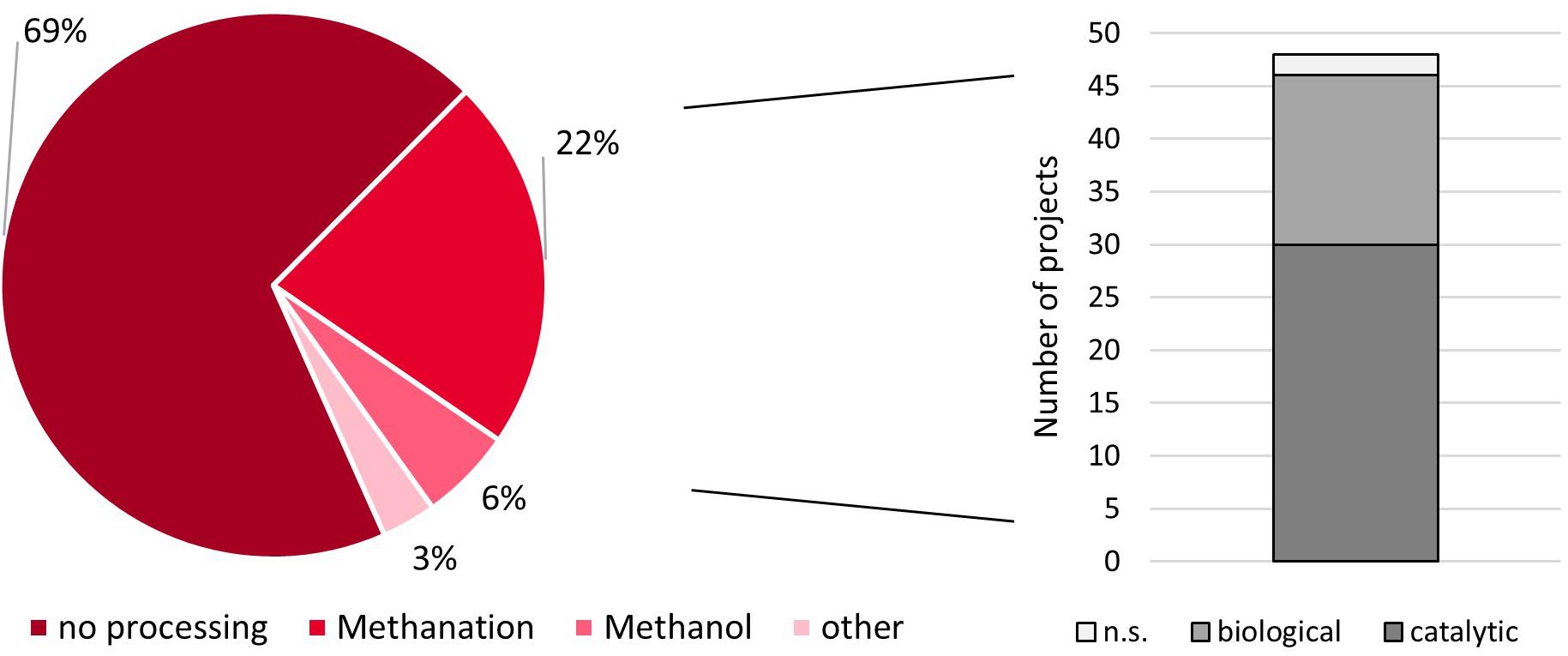
Figure 8. Process steps of Power-to-X projects in Europe with a focus on methanation technologies, n.s., not specified.
Fields of Application
Fields of application include the blending of the produced gas – mainly hydrogen or methane – into the national gas grids; the production of fuels for mobility applications, for example hydrogen in fuel cell electric vehicles, methane, methanol, or Fischer-Tropsch fuels in internal combustion engines; use of the produced gases in CHP plants and use of the gases in industry, for example refineries or steel plants. For some projects, no such purpose was detected3.
Although projects were already being developed in the early 2000s whose main field of application was fuel production, the dominance of such projects is a rather recent trend. In our previous article from 2018 (Wulf et al., 2018), blending gases into the natural gas grid was the most common form of application. In that article, we mentioned that the interest in industrial applications is growing, a trend which has proven to be true. Although no further CHP projects are scheduled for after 2023, this does not mean they will no longer be implemented. If the Exytron projects and the Vårgårda housing project prove to be successful, similar projects will arise. However, these projects have rather small installed electrolyzer capacities (below 500 kW) and are easily overlooked.
As can be seen in Figure 9, in the context of fuel production, PtX is the most common field of application in Europe with a 37% share of all projects. In some countries, there is a preference for certain applications. This is most apparent in the United Kingdom, for instance, where fuels are produced in the majority (67%) of the projects. The main driver behind this trend in the United Kingdom is ITM Power (ITM, 2020b), a company which produces electrolyzers as well as owning and operating several hydrogen refueling stations in the United Kingdom and France. In Germany, the greatest number of projects are also in the field of fuel production (32%). However, significant numbers of projects are found in all fields of application. Compared to other countries, industrial-based PtX projects are of higher interest. The trend toward industrial PtX applications is also likely to increase, as one of the aims of Germany’s National Hydrogen Strategy (Die Bundesregierung, 2020) is to foster industrial applications. Furthermore, in the field of mobility, aviation, shipping, and heavy-duty vehicles are more likely to be funded than individual mobility. Denmark is another country with a clear preference for a certain technological purpose. In Denmark, 57% (8) of all projects are blending the produced gas into the natural gas grid. A methanation plant is used in seven out of the eight Danish projects, primarily biological methanation. However, these projects were all commissioned in the past; in the future, they will also focus on industrial applications and fuel production. In the Netherlands, the focus is on blending and industrial projects. The development of industrial applications is a rather recent trend of the 2020s. Based on the number of projects in France, the most common field of application is fuels. The seven recently approved ADEME projects (see section “General information”) will contribute significantly to this development. Based on the installed capacities, fuels are also important with the HyGreen Provence projects (Le Hen, 2019). Furthermore, in future projects, multiple fields of application are increasingly being targeted, for example Norddeutsches Reallabor (BMWi, 2019). Such projects are listed in the Supplementary Material.
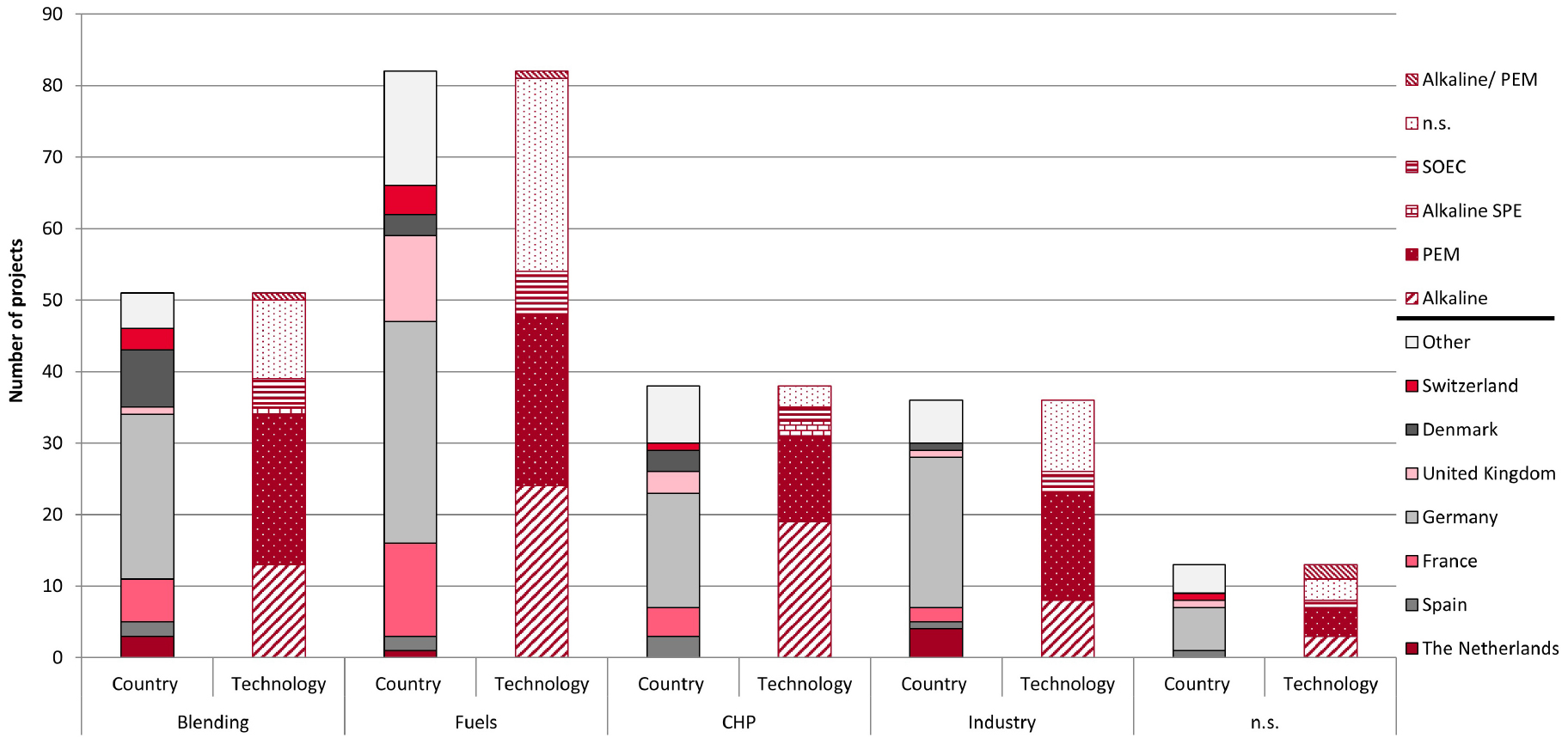
Figure 9. Fields of application for Power-to-X projects according to countries and technologies. PEM. polymer electrolyte membrane; SOEC, solid oxide electrolyzer cell; SPE, solid polymeric electrolyte.
Certain types of electrolyzer are preferred for different fields of application (see Figure 9). For CHP purposes, an alkaline electrolyzer is used in almost 50% of the projects, whereas for industrial applications, a PEM electrolyzer is used in 47% of the projects. However, the use of industrial applications and PEM electrolyzers has increased significantly in recent years (Figure 10), which explains the correlation between these two parameters. The trend toward the renewed usage of alkaline electrolyzers in the upcoming years is mainly driven by the CHP Exytron projects (Schirmer, 2020). They all use alkaline electrolyzers, since they are more technically mature and less expensive. Furthermore, this is one of the few cases where customers are already starting to see economic viability (Schirmer, 2020). As the SOEC technology is less mature than PEM and alkaline electrolyzers, it is not surprising that this type of electrolyzer has yet to find a preferred field of application. Many projects planned for the future have not yet specified the type of electrolyzer used, which leads to the assumption that there is no strong connection between electrolyzer technology and fields of application. However, this line of argumentation is contradicted by the fact that some companies, such as Exytron, are using alkaline electrolyzers for CHP, while Sunfire is using SOECs and Fischer–Tropsch for fuel production in numerous projects.
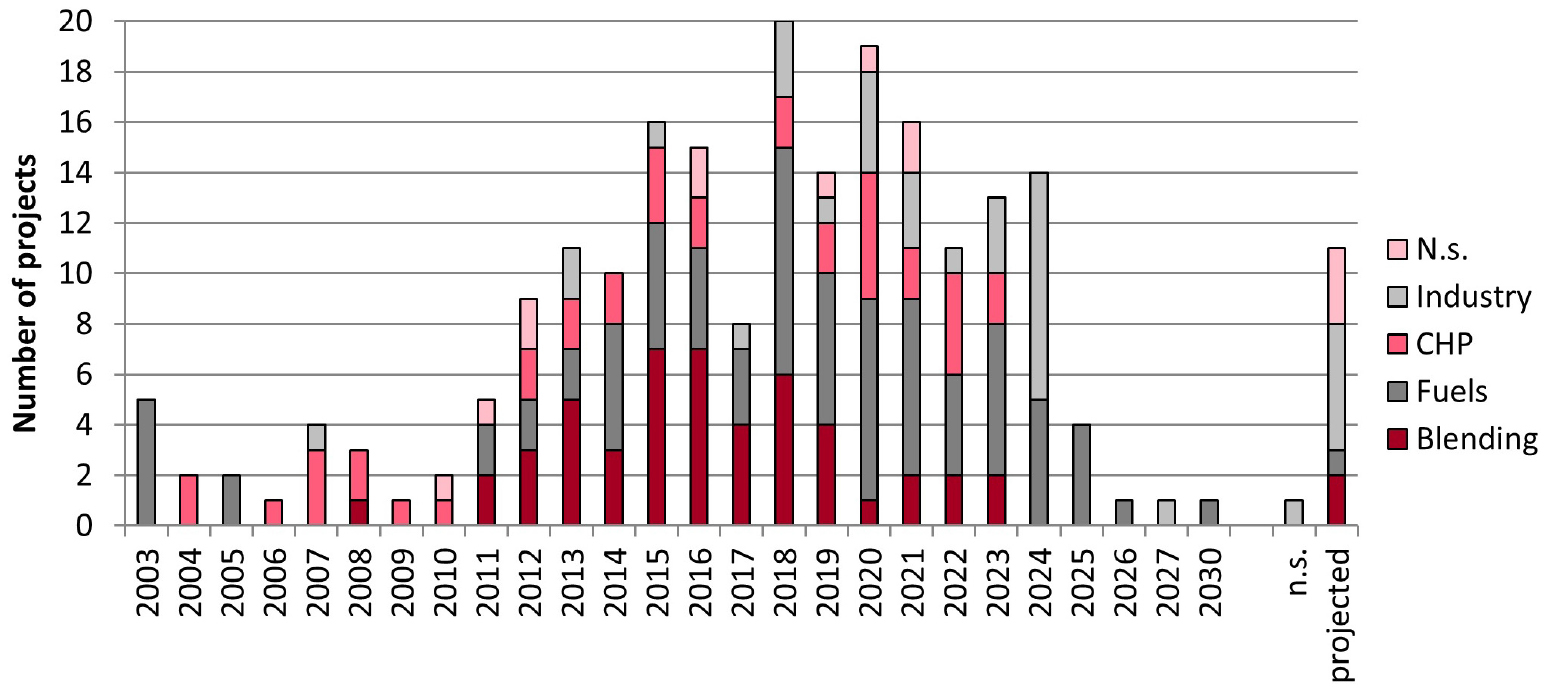
Figure 10. Historical development of Power-to-X projects with regard to fields of application. CHP, combined heat and power, n.s., not specified.
As mentioned above, CHP projects most often have installed electrolyzer capacities below 500 kW. No such correlation can be drawn for fuel production, however, since it might refer to onsite hydrogen production at one hydrogen refueling station (e.g., Løkke and Simonsen, 2017) or centralized e-fuel production (e.g., Thomsen, 2019).
Conclusion
This analysis has shown that the development of PtX technologies is progressing quickly and will continue to do so in the near future. The planning and commissioning of PtX projects is expanding at a rapid rate. A new project is announced almost every week. This review therefore provides merely a snapshot of this development. Although the maximum number of commissioned plants was already reached in 2018 and fewer projects will be initiated in the upcoming years, installed electrolyzer capacities are getting larger and larger. This indicates that a consolidation is taking place, as fewer projects are closer to commercialization. The development of PEM and alkaline electrolyzer technologies has been good and these technologies are used very often, although there seems to be an apparent preference for the more mature alkaline technology in the future. Solid oxide electrolyzer cells are catching up in their technological development with multi-MW projects. However, the development of commercial applications is limited to one company (Sunfire), whereas several companies are involved in the development of PEM and alkaline electrolyzers. Methanation is used in many applications and has proven its feasibility for hydrogen processing. The choice between biological and catalytical methanation seems to be more a question of the project’s aim rather than one of its technical maturity. Only a handful of projects are focusing on the production of liquid fuels, despite the fact that such fuels will be crucial for defossilized energy systems (Ram et al., 2019; Bauer and Sterner, 2020). Greater effort needs to be made in terms of liquid fuel production. The different technological developments of PtX technologies gives reason to believe that in the future we will see a division of major projects fostering technologies on the edge of commercialization. However, small projects will focus on technological development rather than large-scale implementation. This might also include the valorization of co-products, in particular oxygen. Very little effort has been made in terms of the use of oxygen, for example in wastewater treatment plants and innovative heat integration strategies.
Most of the discussed projects are dependent on public funding. However, the different technologies are getting closer to commercialization. This is also underlined by the introduction of the IPCEI on hydrogen. This should allow new countries, for example Portugal and eastern European countries, to participate in PtX projects. Furthermore, these projects will ensure the installation of sufficient capacities of RE, mainly wind and photovoltaics. The roll-out of new RE generation facilities is a prerequisite for many countries to enable the nationwide use of PtX technologies for the defossilization and decarbonization of the future economy; whether PtX is directly coupled with the generation of electricity or the use of RE sources is ensured by certificates.
Although 220 projects in 20 different countries have been identified in Europe, a clear regional focus has been established with France and Germany as the leading countries. Both countries plan to install around 500 MW of capacity by 2025. In Germany, this capacity will be reached through many different projects with various purposes and motives. In France, however, it is an altogether more concentrated effort involving one company. With PtX technologies still in the pre-commercialization stage, the diversified strategy with distributed risks appears to be the more sustainable one. Other very active countries are Denmark and the Netherlands. Both countries border on the North Sea, where the large potential for offshore and onshore wind can guarantee the efficient production of hydrogen and other PtX products.
Author Contributions
CW conducted the research and undertook most of the writing. PZ helped to conceptualize the manuscript, as well as support the analysis, and give a critical review. AS helped with the research and gave a critical review. All authors contributed to the article and approved the submitted version.
Funding
This work was funded by the Helmholtz Association of German Research Centres.
Disclaimer
Frontiers Media SA remains neutral with regard to jurisdictional claims in published maps and institutional affiliations.
Conflict of Interest
The authors declare that the research was conducted in the absence of any commercial or financial relationships that could be construed as a potential conflict of interest.
Supplementary Material
The Supplementary Material for this article can be found online at: https://www.frontiersin.org/articles/10.3389/fenrg.2020.00191/full#supplementary-material
Abbreviations
CO2, carbon dioxide; H2, hydrogen; H2O, water; ADEME, Agence de l’environnement et de la maîtrise de l’énergie; CCU, carbon capture and use; CCS, carbon capture and storage; CHP, combined heat and power; CUTE, Clean Urban Transport for Europe; DAC, direct air capture; DME, dimethyl ether; DVGW, German Technical and Scientific Association for Gas and Water; DWV, German Hydrogen and Fuel-Cell Association; EU, European Union; IEA, International Energy Agency; IPCEI, Important Project of Common European interest; MWT, municipal waste treatment; n.s., not specified; OME, polyoxymethylene dimethyl ether; PEM, polymer electrolyte membrane; PtG, Power-to-Gas; PtX, Power-to-X; R&D, research & development; RE, renewable energy; SOEC, solid oxide electrolyzer cell; SPE, solid polymeric electrolyte; UK, United Kingdom; VRE, variable renewable energy.
Footnotes
- ^ https://www.bmwi.de/Redaktion/EN/Dossier/regulatory-test-beds-testing-environments-for-innovation-and-regulation.html
- ^ Many projects do not announce when they have shut down. For this reason, no information about active projects is available and capacities are cumulative; projects using PEM and alkaline electrolyzers are counted separately according to the technology used; due to the small number of projects using alkaline SPE, they have been excluded from this diagram.
- ^ For this analysis, only one main purpose is counted, despite the fact that several projects use hydrogen for several purposes.
References
Andika, R., Nandiyanto, A. B. D., Putra, Z. A., Bilad, M. R., Kim, Y., Yun, C. M., et al. (2018). Co-electrolysis for power-to-methanol applications. Renew. Sustain. Energy Rev. 95, 227–241. doi: 10.1016/j.rser.2018.07.030
Bailera, M., Lisbona, P., Romeo, L. M., and Espatolero, S. (2017). Power to Gas projects review: lab, pilot and demo plants for storing renewable energy and CO2. Renew. Sustain. Energy Rev. 69, 292–312. doi: 10.1016/j.rser.2016.11.130
Bauer, F., and Sterner, M. (2020). Power-to-X im kontext der energiewende und des klimaschutzes in Deutschland. Chem. Ing. Tech. 92, 85–90. doi: 10.1002/cite.201900167
Bauer, S. (2016). Underground Sun Storage: Den Sonnenschein speichern. Vienna: RAG Rohöl-Aufsuchungs Aktiengesellschaft.
BIGH2IT (2017). Building Innovative Green Hydrogen Systems in Isolated Territories. Zaragoza: Fundación Hidrógeno Aragón.
Binder, M., Faltenbacher, M., Kentzler, M., and Schuckert, M. (2006). Clean Urban Transport for Europe Project No. NNE5-2000-00113: Final Report. Ulm: EvoBus GmbH.
BMBF (2018). Modulare und Autarke Technologien zur Umsetzung von Synthesegas in Kohlenwasserstoff und langkettige Alkohole. Berlin: German Federal Ministry of Education and Research.
BMWi (2019). Gewinner des Ideenwettbewerbs “Reallabore der Energiewende” – Steckbriefe –. Berlin: German Federal Ministry of Economic Affairs and Energy.
Bottrell Hayward, N. (2020). K gears up for hydrogen heating, H2. Int. J. Hydrogen Fuel Cells 48–49.
Büssers, A. (2019). Grüner Wasserstoff aus Wyhlen: Behörden Geben Grünes Licht. Laufenburg: Energiedienst Holding AG.
Chehade, Z., Mansilla, C., Lucchese, P., Hilliard, S., and Proost, J. (2019). Review and analysis of demonstration projects on power-to-X pathways in the world. Int. J. Hydrogen Energy 44, 27637–27655. doi: 10.1016/j.ijhydene.2019.08.260
Die Bundesregierung (2020). Die Nationale Wasserstoffstrategie. Berlin: German Federal Ministry of Economic Affairs and Energy.
DVGW (2019). Wo aus Wind und Sonne grünes Gas wird. Eine Übersicht der Power-to-Gas-Projekte in Deutschland. Bonn: Deutscher Verein des Gas- und Wasserfaches.
E1 (2019). Element Eins: Energiewende Mit Sektorkopplung - Intelligent. Innovativ. Effizient. Dortmund: Thyssengas GmbH.
EU (2014). G. Technology readiness levels (TRL)”, in: Horizon 2020 - Work Programme 2014-2015: General Annexes. Brussels: European Commission.
European Commission (2020). Multimegawatt High-Temperature Electrolyser to Generate Green Hydrogen for Production of High-Quality Biofuels. Luxembourg: Publications Office of the European Union.
Exytron (2019). Nachhaltige Energieversorgung für Bestands- und Neubauten im Natur- und Freizeitgebiet BernsteinSee. Rostock: EXYTRON Vertrieb GmbH.
Fasihi, M., Efimova, O., and Breyer, C. (2019). Techno-economic assessment of CO2 direct air capture plants. J. Clean. Prod. 224, 957–980. doi: 10.1016/j.jclepro.2019.03.086
FReSMe (2017). From Residual Steel Gases to Methanol. Madrid: I-deals Innovación & Tecnología Venturing Services.
FuelCellsWorks (2020a). France: ADEME Supports 10 New Hydorgen Mobility Projects. Available online at: https://fuelcellsworks.com/news/france-ademe-supports-10-new-hydrogen-mobility-projects/ (accessed June 04, 2020).
FuelCellsWorks (2020b). Hydrogen-Powered Trolleybuses put into Service in Riga. Available online at: https://fuelcellsworks.com/news/hydrogen-powered-trolleybuses-put-into-service-in-riga/ (accessed June 10, 2020).
Gahleitner, G. (2013). Hydrogen from renewable electricity: an international review of power-to-gas pilot plants for stationary applications. Int. J. Hydrogen Energy 38, 2039–2061. doi: 10.1016/j.ijhydene.2012.12.010
H&R (2017). Hansen & Rosenthal Weiht Weltgrössten Elektrolyseur Für Umweltfreundlichen Wasserstoff ein. Hamburg: H&R Gruppe.
Hänel, G., Krautz, H.-J., and Weber, H. (2019). Referenzkraftwerk – Lausitz: Vom Braunkohlenkraftwerksstandort zum Energie- und Industriepark für neue Technologien: Speicherkraftwerk mit Sektorenkopplung. Spremberg: Zweckverband Industriepark Schwarze Pumpe.
Hulshof, D., Jepma, C., and Mulder, M. (2019). Performance of markets for European renewable energy certificates. Energy Policy 128, 697–710. doi: 10.1016/j.enpol.2019.01.051
ITM (2020a). Industrial Scale Renewable Hydrogen Project Advances to next phase. Sheffield: ITM Power.
Le Hen, A. (2019). Hygreen Provence: Production, stockage massif et valorisation d’H2 vert. Marseille: Durance Luberon Verdon Agglomération.
localhy (2019). localhy - The Real Energy Transition. Erfurt: donner+friends UG (haftungsbeschränkt) & Co. KG.
Løkke, J. A., and Simonsen, B. (2017). Awarded Contract for Hydrogen Electrolyser and Fueling Station in Estonia. Oslo: Nel Hydrogen Solutions.
MefCO2 (2019). MefCO2: Methanol fuel from CO2. Madrid: I-deals Innovación & Tecnología Venturing Services, S.L.
Meillaud, L. (2019). Le Projet d’usine de H2V Soumis à Concertation en Normandie. Paris: H2V Industry.
Moser, P., Wiechers, G., Schmidt, S., Stahl, K., Majid, M., Heberle, A., et al. (2018). “Demonstrating the CCU-chain and sector coupling as Part of ALIGN-CCUS - dimethyl ether from CO2 as chemical energy storage, fuel and feedstock for industries,” in Proceedings of the Greenhouse Gas Control Technologies (GHGT) conference (Melbourne: GHGT).
Norsk e-Fuel (2020). Norsk e-Fuel is Planning Europe’s first Commercial Plant for hydrogen-Based Renewable Aviation Fuel in Norway. Oslo: Norsk e-Fuel.
NSWPH (2019). Modular Hub-and-Spoke Concept to Facilitate Large Scale Offshore Wind. Dogger Bank: NSWPH.
Ram, M., Bogdanov, D., Aghahosseini, A., Gulagi, A., Oyewo, S. A., Cild, M., et al. (2019). Global Energy System based on 100% Renewable Energy – Power, Heat, Transport and Desalination Sectors. Berlin: Energy Watch Group.
Rubio, J., Cortés, P., Escudero, M. T., de Godos, I., Lana, J. A., Navarro, R., et al. (2016). “RENOVAGAS: process for the production of renewable natural gas,” in Proceedings of the 21st World Hydrogen Energy Conference (Zaragoza: WHEC).
Saveuse, H. (2020). HyGreen Provence : GRDF rejoint le Consortium D’entreprises Partenaires du Projet. Marseille: Travaux Publics & Bâtiment du Midi.
Schirmer, K. (2020). RE: AW: EXYTRON - AW: Review of Power-to-Gas Projects in Europe. Type to C. Wulf.
Stark, C., Thompson, M., Andrew, T., Beasley, G., Bellamy, O., Budden, P., et al. (2019). Net Zero The UK’s Contribution to Stopping Global Warming. London: Committee on Climate Change.
Sveinbjörnsson, D., and Münster, E. (2017). WP1: Gas Conditioning and Grid Operation - Upgrading of Biogas to Biomethane with the Addition of Hydrogen from Electrolysis. Skørping: PlanEnergi.
Thema, M., Bauer, F., and Sterner, M. (2019). Power-to-gas: electrolysis and methanation status review. Renew. Sustain. Energy Rev. 112, 775–787. doi: 10.1016/j.rser.2019.06.030
Viessmann. (2019). Grünes Licht für Erste Industrielle Power-to-Gas-Anlage im SCHWEIZERISCHEN DIETIKOn. Deutsche Technologie- und Entwicklungspartner sind die beiden Viessmann Tochterunternehmen microbEnergy und Schmack Biogas sowie Siemens. Allendorf: Viessmann Werke GmbH & Co. KG.
voestalpine (2019). H2FUTURE: World’s largest “green” hydrogen pilot facility successfully Commences Operation. Linz: voestalpine AG.
Wang, L., Rao, M., Diethelm, S., Lin, T.-E., Zhang, H., Hagen, A., et al. (2019). Power-to-methane via co-electrolysis of H2O and CO2: the effects of pressurized operation and internal methanation. Applied Energy 250, 1432–1445. doi: 10.1016/j.apenergy.2019.05.098
Keywords: Power-to-Gas, Power-to-X, hydrogen, methanation, electrolysis, R&D project, review
Citation: Wulf C, Zapp P and Schreiber A (2020) Review of Power-to-X Demonstration Projects in Europe. Front. Energy Res. 8:191. doi: 10.3389/fenrg.2020.00191
Received: 06 April 2020; Accepted: 17 July 2020;
Published: 25 September 2020.
Edited by:
Luis M. Romeo, University of Zaragoza, SpainReviewed by:
Ligang Wang, École Polytechnique Fédérale de Lausanne, SwitzerlandXiao-Yu Wu, University of Waterloo, Canada
Manuel Bailera, University of Zaragoza, Spain
Copyright © 2020 Wulf, Zapp and Schreiber. This is an open-access article distributed under the terms of the Creative Commons Attribution License (CC BY). The use, distribution or reproduction in other forums is permitted, provided the original author(s) and the copyright owner(s) are credited and that the original publication in this journal is cited, in accordance with accepted academic practice. No use, distribution or reproduction is permitted which does not comply with these terms.
*Correspondence: Christina Wulf, c.wulf@fz-juelich.de
 Christina Wulf
Christina Wulf Petra Zapp
Petra Zapp Andrea Schreiber
Andrea Schreiber